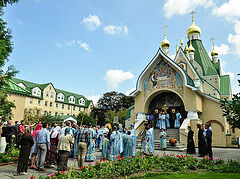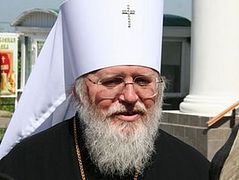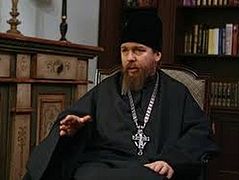I am very pleased that Archpriest Andrei Sommer, dean of the main church of the Russian Orthodox Church Outside of Russia—the Synodal Cathedral of the Sign, agreed to speak with me and answer all my questions, telling me about the pillars of ROCOR, and about his own spiritual path. Here are his stories.—Olga Rozhneva
I think in Russian
We had the Church of All Saints Who Have Shown Forth in the Russian Land, and I can say that I was raised and educated in this parish—I started serving in the altar when I was seven. I studied in an Orthodox school, and we were taught Russian history, Russian geography, and the Law of God. It was an island of Russia in America.
And when people ask me now what I, having been born in America, feel like—Russian or American—I answer:
“Of course, I am Russian. Dahl1 said: ‘Whatever language you think in, that’s the people you belong to.’ I think in Russian.”
Fr. Nikolai Masich
My first spiritual mentor was the rector of our church, Protopresbyter Nikolai Masich. He experienced a lot of suffering in his life and was persecuted for the faith. He worked as a math teacher before the revolution and for a few years after it, but then they demanded that he as a teacher become an atheist, and in 1925 he had to leave his job.
As a zealous parishioner and reader, Fr. Nikolai was ordained to the diaconate, and then to the priesthood. He was ordained in those terrible years when serving at the altar meant putting yourself and your family in mortal danger. And this danger was not long in coming. Fr. Nikolai was arrested for the faith and spent twenty years in camps, and his matushka raised their three daughters on her own. When he returned from the camp, his matushka had already died, and he wasn’t even able to be at her burial. His daughters were long since grown.
After the war, Fr. Nikolai was part of the emigration and experienced the Tragedy of Lienz.2 Then he served in the Church of St. John the Forerunner in Buenos Aires. He was the rector of our church in Burlingame when I started serving there, and he departed to the Lord in 1974.
Fr. Alexei Ionov
After Fr. Nikolai, the rector of our church was Protopresbyter Alexei Ionov (1907-1977). His recollections of his years of service in the Pskov Orthodox Mission were the basis for Vladimir Khotinenko’s film “Pop,” based on the novel of the same name by Alexander Segen.
Fr. Alexei wasn’t so old when he started serving at our church, but he experienced so many sorrows during the war that on his last Pascha, he wasn’t able to go out for the procession. I remember how happy we all where when he gathered his strength and came out to congratulate us all! I was still a young boy then and I remember little, but I remember his spirit… Fr. Alexei greatly influenced my desire to serve God.
“For Jesus’ sake, not to have some bread to taste”
Then we had other priests… My generation knew many rectors—true pastors who gave their souls for their sheep.
It’s no surprise that I made my choice in life early, and while my American peers were dreaming of a career and a high-paying job, we Russian boys were going off to Holy Trinity Seminary, already aware that the ministry of a priest in America would not enable us to feed our families, that we would always have to work somewhere or rely on our matushkas’ salaries. We went to seminary for Jesus’ sake, not to have some bread to taste, as the proverb says.
And that’s how it turned out for me in life: My matushka and I raised three sons on her salary as a university professor, while I served at the altar of God; and I have been serving for thirty years now. But I’m getting ahead of myself.
Vladyka Anthony (Medvedev)
 Archbishops Laurus and Anthony, 1988
Archbishops Laurus and Anthony, 1988
When I was studying at the Orthodox school, Archbishop Anthony (Medvedev, 1908-2000) would often come visit us, especially during exams. He was the main force behind the glorification of St. John of Shanghai. It was Vladyka Anthony who led the opening of the holy hierarch’s relics in 1993 and composed the lion’s share of the service to him.
This is what Metropolitan Laurus wrote about Vladyka Anthony:
“He was very heartfelt and sincere and never did anything for himself, but only for the good of the Church and to the glory of God. He had no personal life, but only a life for the Church, with Christ.”
Vladyka Anthony was tall, balding, not fat, but so big, with big hands, like a bear, as if living up to his last name.3 He was strict with us, but with great love.
I remember when I got a question about the Ecumenical Councils at one of the exams, and I forgot one of the many dates—he moved a little away from the table, so the other teachers wouldn’t notice, and quietly prompted me.
All the students of the Orthodox school kept the fasts, and the rector of our church confessed us all. There were about eighty students, and it was hard for him, so Vladyka Anthony came to help him and confessed us himself—although he had his own Orthodox school at the cathedral in San Francisco with more than 100 students. That is, Vladyka dealt not only with his own students, but never forgot about us either.
I graduated from the school in 1982, and Vladyka Anthony gave me a medal and a copy of the New Testament, which I still have. He also tonsured me as a reader on the patronal feast of All Russian Saints and blessed me to go to seminary.
 The New Testament given by Vladyka Anthony
The New Testament given by Vladyka Anthony
Metropolitan Philaret (Voznesensky)
We were also visited by Vladyka Philaret (Voznesensky, 1903-1985), the third First Hierarch of the Russian Church Abroad, the Metropolitan of New York and Eastern America. We had a unique parish—the First Hierarchs would visit us. And he brought us the wonderworking Kursk Root Icon.
I would hold Metropolitan Philaret’s heavy staff while he preached, and his sermons were, I can tell you, by no means short.
I remember how as an eleven-year-old boy I received a gramota signed by Vladyka Philaret for diligently helping out at the parish. I cherish this commemorative gramota very much.
 Gramota with Metropolitan Philaret’s signature
Gramota with Metropolitan Philaret’s signature
How I met my betrothed
At the time, Archpriest Stefan Pavlenko was the rector of our church. A young girl came to visit his Matushka Tatiana—it was her niece. And that’s how I met my future wife Natasha.
When I went to seminary at Holy Trinity Monastery, Protopresbyter Michael Pomazansky (1888–1988), a famous theologian of the Russian Church Abroad, was living at the monastery. I soon saw Natasha again, this time having come to visit Fr. Michael. It turns out the famous theologian was her great-grandfather. By the way, he reposed less than a week shy of his one-hundredth birthday.
Natasha and I got married when I was in my third year.
“I want to ordain you to the diaconate”
A year after our wedding, when I was in my fourth year, Vladyka Anthony called me:
“I tonsured you as a reader, I blessed you to go to Jordanville, and now I bless you to come here on summer vacation: I want to ordain you to the diaconate.”
Before the ordination, Vladyka invited Natasha and I to come for tea, to his modest apartment, apparently to get to know my darling and future matushka better.
He had such a huge desk, all covered with papers, but it was obvious that he knew quite well what was where. Vladyka was a very active person, working for days on end. He didn’t serve every day, but he went and prayed at all the services.
Natasha wanted to help him set the table but he declined, pouring the tea and getting the food out of the refrigerator himself.
 My ordination to the diaconate
My ordination to the diaconate
My ordination
My ordination took place together with the hierarchical consecration of Vladyka Kyrill (Dmitrieff) on June 7, 1992, at the San Francisco cathedral. Hierarchical consecrations occur at the beginning of the Liturgy and diaconal ordinations after the Anaphora.
And so, first Bishop Kyrill was consecrated, and then all the gathered hierarchs—Vladyka Laurus, Vladyka Vitaly (Ustinov), Vladyka Anthony, Vladyka Hilarion (Kapral) (three of them were the First Hierarchs of the Russian Church Abroad at different times), made way for the newly-consecrated Bishop Kyrill, and his first hierarchical ordination was my ordination to the diaconate.
It’s a very beautiful tradition, when ruling hierarchs defer to a newly-consecrated hierarch. The next morning, all the bishops again deferred to Bishop Kyrill to serve the Liturgy, and they prayed in the altar while he served his first hierarchical Liturgy. And the cathedral’s protodeacon, Fr. Nikolai Porshnikov, also deferred to me.
It’s a big cathedral, and I was a fourth-year seminarian, just ordained to the diaconate; for me to serve in this cathedral, in the presence of so many hierarchs, was a real test—both joyful and frightening. I experienced such reverential trepidation.
 My first diaconal litany with Protodeacon Nikolai Porshnikov
My first diaconal litany with Protodeacon Nikolai Porshnikov
“You don’t need any cheat sheet!”
After my ordination, I served in the Cathedral of the Joy of All Who Sorrow for a whole week, and the week after that was the feast of Pentecost. As the junior deacon, I was supposed to carry the Gospel at the Vigil, at the Polyeleos, and read the prokimenon.
I remember that I was very worried that I would forget the prokimenon from all the excitement, so I started to write out a cheat sheet. Then Protodeacon Nikolai Porshnikov calmed me down and said:
“You don’t need any cheat sheet: If you forget, just lift your head and look up.”
I looked and saw that there is an icon in the cathedral dome—and the prokimenon for the feast written there.
A Russian knight
Protodeacon Nikolai Porshnikov (†2004) was unique. I’ve never seen any other protodeacons like him. First, he was an enormous man, a real Russian knight; second, he had a wonderful voice—he had a strong, powerful bass.
Fr. Nikolai began his path of service to the Church in Harbin, and in his youth he would hold the staff for Metropolitan Nestor (Anismov, †1962) of Kamchatka.
They tell a story about how Fr. Nikolai, as a seminarian at Jordanville, in his youthful zeal, brought a huge rock right into his cell, in order to secretly pray on it, in imitation of St. Seraphim. These prayers of his were discovered by chance when some new seminarians were assigned to his cell and he apparently hadn’t had a chance to carry the rock out. Several of the young men had to help carry it out. None of them could have done it alone, as Fr. Nikolai had done.
He was ordained in 1963 by St. John of Shanghai himself, whom Fr. Nikolai greatly revered. Many remember how Fr. Nikolai wept when the coffin was brought to the cathedral with the body of St. John, who departed to the Lord on July 2, 1966 in Seattle while praying in his cell before the wonderworking Kursk Root Icon.
About the reconciliation
In 1994, I was ordained to the priesthood. I served in several parishes, and now for twenty years I’ve been serving in the main church of the Russian Church Abroad—the Synodal Cathedral of the Sign.
I am the dean of the cathedral, and I’m also involved in the Synod’s work with youth, working on various youth projects.
I have been with three First Hierarchs of our Church; or rather, I’m now serving under the third. The reconciliation and reunification of the Russian Church Abroad with the Russian Orthodox Church of the Moscow Patriarchate took place under the second of them, Metropolitan Laurus.
 Youth Day at the Synodal cathedral
Youth Day at the Synodal cathedral
I remember how President Putin came before the reconciliation, how he prayed before the wonderworking Kursk Root Icon. Then he lit a candle before it. He started speaking with our First Hierarch, Metropolitan Laurus, and we all thought the conversation would be purely formal, lasting maybe five to seven minutes. But to our surprise, it lasted about an hour, and we saw how interesting it was for Putin to speak with someone like our Metropolitan Laurus. We saw how sincerely interested the President was in the reconciliation… He also said that he and his administration were ready to help any way they could towards the reconciliation—and that was basically our life at that time. You could say it was the main thing for us.
 Meeting with President Putin at the Synodal headquarters
Meeting with President Putin at the Synodal headquarters
Vladyka Tikhon (Shevkunov), then still an archimandrite, also came to see us. He worked very hard to ensure that the reconciliation happened…
 Metropolitan Laurus and Metropolitan (then Archimandrite) Tikhon (Shevkunov)
Metropolitan Laurus and Metropolitan (then Archimandrite) Tikhon (Shevkunov)
 The service of reunification with the Moscow Patriarchate on May 17, 2007
The service of reunification with the Moscow Patriarchate on May 17, 2007
Later, six of the clerics who had carried out all the difficult work of preparing for the reconciliation and reunification received Russian citizenship by decree of President Putin, myself included. It was a great gift for us from the President. So now besides American citizenship, I also have Russian citizenship, which I’m very proud of.
 Signing the Act of Canonical Communion with the Russian Orthodox Church
Signing the Act of Canonical Communion with the Russian Orthodox Church
To the readers of Pravoslavie.ru/OrthoChristian.com and its head, Metropolitan Tikhon (Shevkunov), I wish God’s help in all good deeds and endeavors! Christ is Risen!








